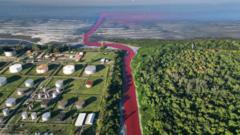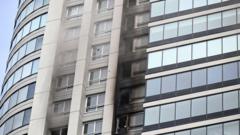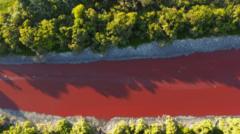A vibrant red hue has overtaken the Sarandí canal in Buenos Aires, alarming residents and prompting investigations into its source. With suspicions pointing towards industrial waste, local authorities are assessing water samples for a thorough analysis.
Disturbing Color Change in Buenos Aires Canal Sparks Environmental Concerns

Disturbing Color Change in Buenos Aires Canal Sparks Environmental Concerns
The Sarandí canal in Buenos Aires has turned bright red, leading to public alarm and inquiries into the potential causes, including industrial waste.
In a surprising and concerning incident, the Sarandí canal, situated in a suburban area of Buenos Aires, has transformed into a bright red color, raising alarms among local residents. The striking visual was captured in various photos and videos that surfaced online. This rare event, reported early on Thursday, is alarming especially as the canal flows into the Rio de la Plata, adjacent to an ecological reserve.
Initial investigations suggest the bright red color may result from the dumping of textile dye or chemical waste from industries in the vicinity. In response to the situation, the Environment Ministry has initiated water sampling from the canal to identify the specific causes behind this drastic color change. By the end of the day, reports indicated that the intensity of the color had diminished somewhat.
Residents have voiced concerns regarding the illegal disposal of toxic waste into the canal, particularly as it slices through an industrial area known for leather processing and textile manufacturing located approximately 10 kilometers (6 miles) from downtown. One resident, Silvia, expressed her alarm while highlighting previous experiences with the canal's water, stating, "other times it was yellow, with an acidic smell that makes us sick even in the throat." She noted that the present state of the water lacked any noticeable odor.
Additional accounts from locals, like Maria Ducomls, revealed a history of different colors in the water, including bluish and lilac shades, often accompanied by a greasy film on the surface. These testimonies raise deep concerns about industrial practices and their potential environmental impacts in the community. As Buenos Aires grapples with broader environmental issues, incidents like this underscore the pressing need for stricter regulations and enforcement to safeguard public health and ecological integrity.
Initial investigations suggest the bright red color may result from the dumping of textile dye or chemical waste from industries in the vicinity. In response to the situation, the Environment Ministry has initiated water sampling from the canal to identify the specific causes behind this drastic color change. By the end of the day, reports indicated that the intensity of the color had diminished somewhat.
Residents have voiced concerns regarding the illegal disposal of toxic waste into the canal, particularly as it slices through an industrial area known for leather processing and textile manufacturing located approximately 10 kilometers (6 miles) from downtown. One resident, Silvia, expressed her alarm while highlighting previous experiences with the canal's water, stating, "other times it was yellow, with an acidic smell that makes us sick even in the throat." She noted that the present state of the water lacked any noticeable odor.
Additional accounts from locals, like Maria Ducomls, revealed a history of different colors in the water, including bluish and lilac shades, often accompanied by a greasy film on the surface. These testimonies raise deep concerns about industrial practices and their potential environmental impacts in the community. As Buenos Aires grapples with broader environmental issues, incidents like this underscore the pressing need for stricter regulations and enforcement to safeguard public health and ecological integrity.



















